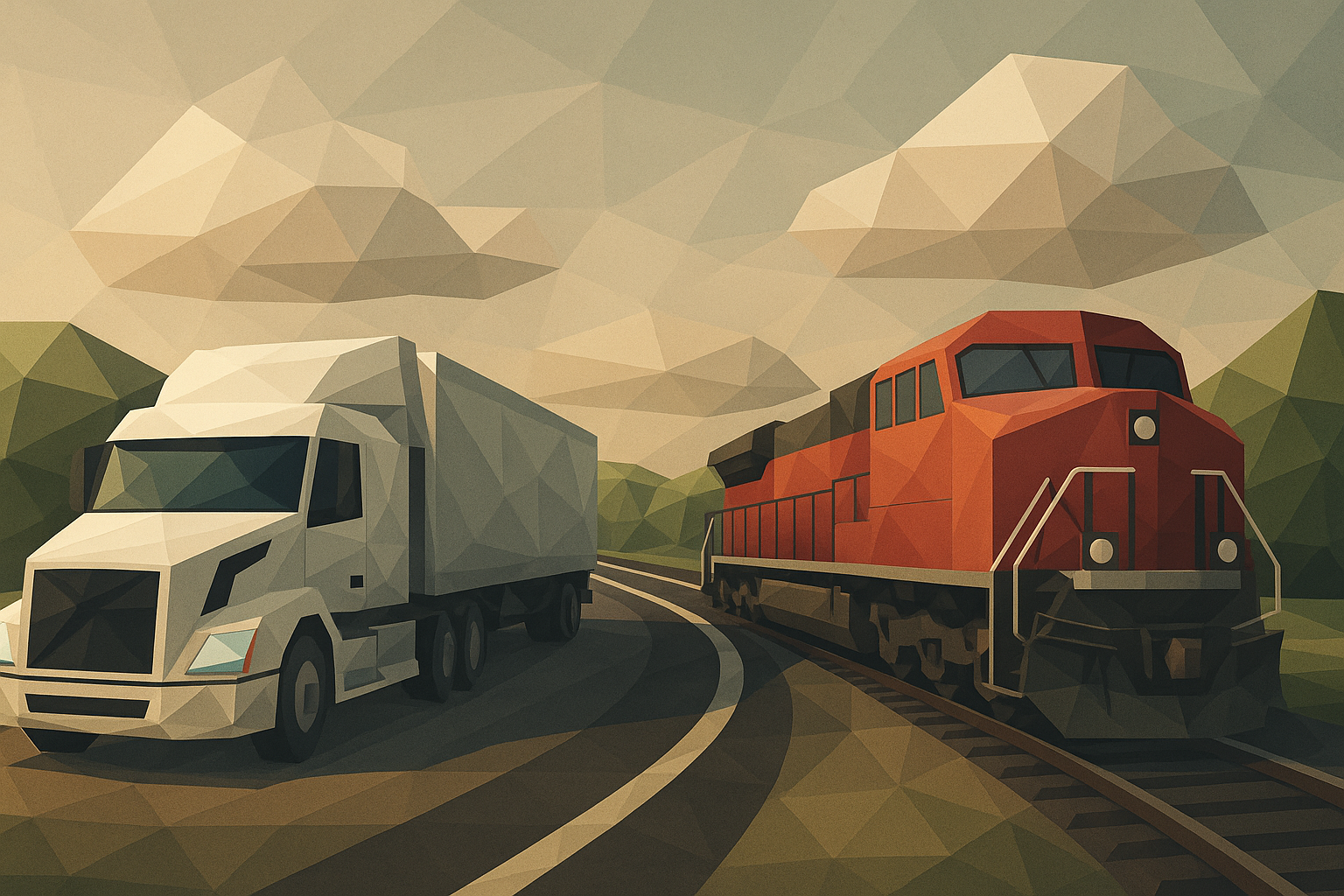Revolutionizing Transportation: How Runink's AI Powers Modal Shift and Route Optimization

TL;DR:
Runink’s AI assistant helps logistics teams make smarter modal-shift decisions by integrating real-time rail and road data. It enhances transport efficiency, lowers operational costs, and supports sustainability—all without the need for massive analytics budgets.
Revolutionizing Transportation: How Runink’s AI Powers Modal Shift and Route Optimization
In a rapidly evolving global logistics landscape, achieving efficiency, cost-effectiveness, and sustainability is crucial. Inefficient transport networks, especially the interchange between rail and truck services, frequently result in under-utilized capacity and increased operational costs. Recent disruptions, such as rising geopolitical tensions impacting key shipping routes, underline the importance of agile, responsive transport optimization. Runink, an advanced AI assistant, steps into this complex scenario with powerful AI-driven solutions for modal shift analysis and real-time route optimization.
Understanding the Transport Optimization Challenge
Recent warnings from global shipowners highlight increasing risks in major shipping channels, especially in sensitive geopolitical regions such as the Gulf. These challenges underscore the urgency for logistics companies to adopt more versatile and reliable multimodal transportation strategies. Traditional inefficiencies in rail-truck interchange hubs and poorly coordinated modal transitions exacerbate delays, raise costs, and significantly impact environmental footprints.
SMEs and larger logistics operators alike grapple with these inefficiencies, seeking tools capable of leveraging dynamic real-time data. However, without sophisticated analytics capabilities, they struggle to optimize transport modes dynamically, leaving vast potential for cost savings and sustainability improvements untapped.
Introducing Runink: AI-powered Route Optimization and Modal-Shift Analysis
Runink harnesses generative AI to deliver advanced analytics, precise route optimization, and dynamic modal shift analysis. Its AI technology integrates real-time data from extensive rail and road networks, enabling logistics companies to identify the most efficient transport modes instantly.
Dynamic Decision-Making Systems
Runink’s strength lies in its dynamic, real-time decision-making capabilities. It continuously processes live data streams from road conditions, rail schedules, intermodal terminal operations, and geopolitical risk assessments. This empowers logistics managers to make proactive and informed choices, ensuring cargo moves via the most optimal and cost-effective modes available.
AI algorithms analyze historical and real-time data to predict transit times, identify congestion hotspots, and suggest alternative routes or modes. With these insights, businesses dramatically reduce delays and enhance overall supply chain responsiveness.
Optimizing Rail-Truck Interchange Efficiency
Runink targets the chronic inefficiencies at rail-truck interchange points, often the weakest link in multimodal transport chains. By predicting congestion patterns, AI-driven insights facilitate smoother transitions between rail and road transport, enhancing the flow of goods through these critical interchange points.
Improved coordination between modes significantly reduces idle time and operational disruptions, contributing directly to increased asset utilization. This ensures rail and truck capacities are consistently maximized, delivering noticeable cost reductions and better service reliability.
Real-Time Modal-Shift Analysis
Modal shift—the strategic transfer of freight between different transportation modes—can provide immense benefits if managed dynamically. Runink’s sophisticated modal-shift analysis continuously evaluates various transport options against multiple criteria, including cost, speed, reliability, and environmental impact.
For example, Runink can quickly determine if switching from road to rail for certain shipments could offer significant cost and emission savings. It dynamically adjusts recommendations based on changing conditions, providing transport managers with actionable, data-driven insights on modal usage.
Core Benefits of Runink’s AI Technology
Maximized Modal Utilization
Through real-time analytics, Runink ensures optimal use of available transport modes. By effectively leveraging under-utilized capacities, logistics companies achieve superior resource efficiency, reducing unnecessary investments in additional assets.
Significant Cost Savings
By optimizing routes and dynamically selecting the most cost-efficient transport modes, Runink substantially reduces logistics costs. Its predictive capabilities also mitigate risks of costly delays or disruptions, improving overall financial performance.
Enhanced Environmental Sustainability
Transport optimization inherently reduces fuel consumption, emissions, and environmental impact. Runink’s precise analytics help companies adopt more sustainable transport strategies, aligning with regulatory requirements and sustainability goals.
Improved Supply Chain Agility
Runink increases supply chain resilience, enabling businesses to swiftly adapt to disruptions, such as geopolitical tensions or infrastructure breakdowns. Enhanced agility ensures logistics operations remain efficient and uninterrupted, even during unforeseen circumstances.
Real-world Applications and Scenarios
Scenario 1: Managing Gulf Region Risks
Recent geopolitical concerns in the Gulf highlight risks associated with maritime transport. Runink can rapidly analyze alternative overland transport modes, redirecting freight via optimized rail and road routes. By dynamically assessing risks and capacities, Runink ensures seamless cargo transitions, avoiding costly maritime disruptions.
Scenario 2: Overcoming Rail-Truck Bottlenecks
In scenarios where rail-truck interchange points experience congestion, Runink proactively identifies emerging bottlenecks and recommends alternative interchange hubs or timing adjustments. This predictive management significantly reduces transit delays, optimizing overall logistics flow.
Scenario 3: Environmentally Conscious Transport
Companies increasingly face mandates for environmental compliance. Runink enables proactive compliance by analyzing transport modes’ emissions and suggesting optimal combinations of rail and road transport to achieve substantial reductions in carbon footprints.
Future-proofing Logistics with Runink
As logistics networks become more complex, Runink provides a clear pathway to continuous improvement. Its scalable AI technology easily integrates with existing logistics management systems, enabling companies to progressively enhance capabilities without substantial infrastructure changes or financial outlays.
Runink’s adaptability ensures that as transportation networks evolve, logistics companies can continuously refine their modal strategies and maintain competitive advantages. The ability to dynamically manage multimodal transport under various circumstances positions businesses to thrive amid uncertainty and market volatility.
Conclusion
Runink represents a transformative advancement in logistics management, using cutting-edge generative AI to address longstanding challenges in modal shift optimization and transport efficiency. By enabling dynamic decision-making, maximizing modal utilization, significantly reducing costs, and improving environmental outcomes, Runink delivers strategic advantages crucial for modern logistics operations.
Adopting Runink ensures logistics companies remain agile, resilient, and sustainable, consistently achieving optimal performance regardless of the complexities presented by global transportation dynamics.
Embrace the power of AI-driven modal-shift analysis and route optimization—experience Runink’s transformative capabilities and lead your logistics strategy confidently into the future.